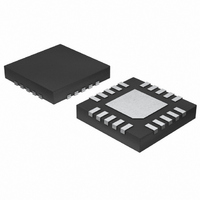MAX4411ETP+ Maxim Integrated Products, MAX4411ETP+ Datasheet - Page 9

MAX4411ETP+
Manufacturer Part Number
MAX4411ETP+
Description
IC AMP AUDIO .08W STER AB 20TQFN
Manufacturer
Maxim Integrated Products
Series
DirectDrive™r
Type
Class ABr
Datasheet
1.MAX4411EBET.pdf
(18 pages)
Specifications of MAX4411ETP+
Output Type
Headphones, 2-Channel (Stereo)
Max Output Power X Channels @ Load
80mW x 2 @ 16 Ohm
Voltage - Supply
1.8 V ~ 3.6 V
Features
Depop, Short-Circuit and Thermal Protection, Shutdown
Mounting Type
Surface Mount
Package / Case
20-TQFN Exposed Pad
Product
General Purpose Audio Amplifiers
Output Power
80 mW
Thd Plus Noise
0.007 %
Operating Supply Voltage
1.8 V to 3.6 V
Supply Current
3.2 mA
Maximum Power Dissipation
1349 mW
Maximum Operating Temperature
+ 85 C
Mounting Style
SMD/SMT
Minimum Operating Temperature
- 40 C
Supply Voltage (max)
3.6 V
Supply Voltage (min)
1.8 V
Amplifier Class
AB
No. Of Channels
2
Supply Voltage Range
1.8V To 3.6V
Load Impedance
16ohm
Operating Temperature Range
-40°C To +85°C
Amplifier Case Style
TQFN
Rohs Compliant
Yes
Lead Free Status / RoHS Status
Lead free / RoHS Compliant
The MAX4411 fixed-gain, stereo headphone driver fea-
tures Maxim’s DirectDrive architecture, eliminating the
large output-coupling capacitors required by conven-
tional single-supply headphone drivers. The device con-
sists of two 80mW Class AB headphone drivers, internal
feedback network, undervoltage lockout (UVLO)/shut-
down control, charge pump, and comprehensive click-
and-pop suppression circuitry (see Typical Application
Circuit). The charge pump inverts the positive supply
(PV
phone drivers operate from these bipolar supplies with
their outputs biased about GND (Figure 1). The drivers
have almost twice the supply range compared to other
3V single-supply drivers, increasing the available output
power. The benefit of this GND bias is that the driver out-
puts do not have a DC component typically V
large DC-blocking capacitors required with convention-
al headphone drivers are unnecessary, thus conserving
board space, system cost, and improving frequency
response.
Each channel has independent left/right, active-low
shutdown controls, optimizing power savings in mixed-
mode, mono/stereo operation. The device features an
undervoltage lockout that prevents operation from an
insufficient power supply and click-and-pop suppres-
sion that eliminates audible transients on startup and
shutdown. Additionally, the MAX4411 features thermal-
overload and short-circuit protection and can withstand
±8kV ESD strikes on the output pins.
The MAX4411 utilizes an internally fixed gain configura-
tion of either -1.5V/V (MAX4411) or -2V/V (MAX4411B).
All gain-setting resistors are integrated into the device,
reducing external component count. The internally set
gain, in combination with DirectDrive, results in a head-
phone amplifier that requires only five tiny 1µF capaci-
tors to complete the amplifier circuit: two for the charge
pump, two for audio input coupling, and one for power-
supply bypassing (see Typical Application Circuit).
Conventional single-supply headphone drivers have their
outputs biased about a nominal DC voltage (typically half
the supply) for maximum dynamic range. Large coupling
capacitors are needed to block this DC bias from the
headphone. Without these capacitors, a significant
amount of DC current flows to the headphone, resulting
in unnecessary power dissipation and possible damage
to both headphone and headphone driver.
Maxim’s DirectDrive architecture uses a charge pump
to create an internal negative supply voltage.
DD
), creating a negative supply (PV
_______________________________________________________________________________________
Detailed Description
80mW, Fixed-Gain, DirectDrive, Stereo
Headphone Amplifier with Shutdown
SS
DirectDrive
Fixed Gain
). The head-
DD
/2. The
This allows the MAX4411 outputs to be biased about
GND, almost doubling dynamic range while operating
from a single supply. With no DC component, there is
no need for the large DC-blocking capacitors. Instead
of two large (220µF, typ) tantalum capacitors, the
MAX4411 charge pump requires two small ceramic
capacitors, conserving board space, reducing cost,
and improving the frequency response of the head-
phone driver. See the Output Power vs. Charge-Pump
Capacitance and Load Resistance graph in the Typical
Operating Characteristics for details of the possible
capacitor sizes. There is a low DC voltage on the driver
outputs due to amplifier offset. However, the offset of
the MAX4411 is typically 0.7mV, which, when com-
bined with a 32Ω load, results in less than 23µA of DC
current flow to the headphones.
Previous attempts to eliminate the output-coupling capac-
itors involved biasing the headphone return (sleeve) to
the DC-bias voltage of the headphone amplifiers. This
Figure 1. Conventional Driver Output Waveform vs. MAX4411
Output Waveform
V
V
OUT
OUT
CONVENTIONAL DRIVER-BIASING SCHEME
DirectDrive BIASING SCHEME
V
GND
GND
V
+V
-V
DD
DD
DD
DD
/2
9












